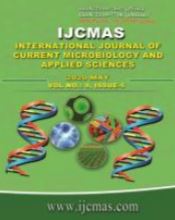


 National Academy of Agricultural Sciences (NAAS)
National Academy of Agricultural Sciences (NAAS)

|
PRINT ISSN : 2319-7692
Online ISSN : 2319-7706 Issues : 12 per year Publisher : Excellent Publishers Email : editorijcmas@gmail.com / submit@ijcmas.com Editor-in-chief: Dr.M.Prakash Index Copernicus ICV 2018: 95.39 NAAS RATING 2020: 5.38 |
Improving and maintaining soil quality for enhancing and sustaining agricultural production is of utmost importance for India’s food and nutritional security. Permanent Manurial Experiments (PMW) are ideal sites for studying management induced variability in crop production and soil health. The biological activity of a soil is the function of number of organisms present in soil and their physiological efficiency. Soil microbial diversity is one of the most important microbial parameters in soil. Cassava is grown throughout the tropics, where it is the fourth most important staple food crop in terms of Kcal consumed per day. Cassava grows reasonably well with little or no fertilizer inputs, the crop does respond well to fertilizer applications in highly infertile soils. In some areas cassava has been cultivated continuously with improper fertilizer management. These factors have caused the soil’s productivity to steadily decline, resulting in a decrease in cassava growth and yield. Another reason for stagnating yields may be the decline in soil productivity as a result of continuous cassava production without adequate fertilization. Hence, Permanent Manurial Experiment (PME) on cassava variety YTP 1 has been conducted for three years during 2014-2017at Tapioca and Castor Research Station, Yethapur, Salem district, Tamil Nadu with four treatments viz., control, organic manuring, inorganic fertilization and integrated nutrient management to study the effects on the yield and quality of cassava and the consequent changes in the biological properties of the soil under continuous cropping with and manuring. Among the treatments, Integrated Nutrient Management (INM) recorded higher plant height (237 cm), stem girth (13 cm), number of tubers (13), tuber length (41.6 cm) and tuber girth (32.2 cm) followed by inorganics and organics. Control recorded lesser plant height (191 cm), stem girth (7.6 cm), number of tubers (8.0), tuber length (19.4 cm) and tuber girth (11.0 cm). The maximum tuber yield (41.50 t ha-1) and starch content (26.50%) was recorded by the application of INM. Higher microbial population of bacteria, fungi and actinomycetes was recorded under organics (65.87, 26.54 and 9.98 respectively) followed by Integrated Nutrient Management (64.38, 25.87 and 9.47 respectively). Therefore, adoption of integrated plant nutrient supply and management strategies for enhancing soil quality, input use efficiency and crop productivity is extremely important for food and nutritional security in Indian agriculture.
 |
 |
 |
 |
 |